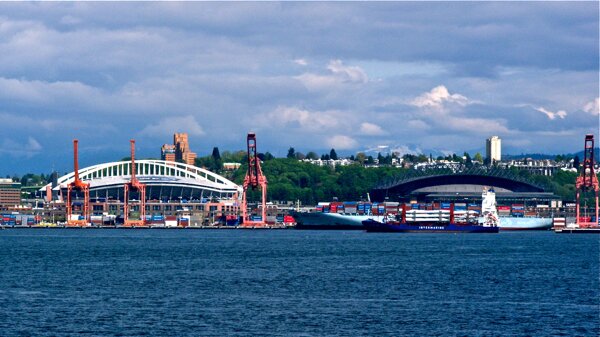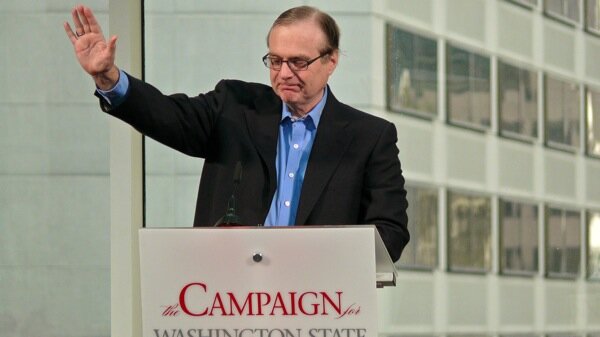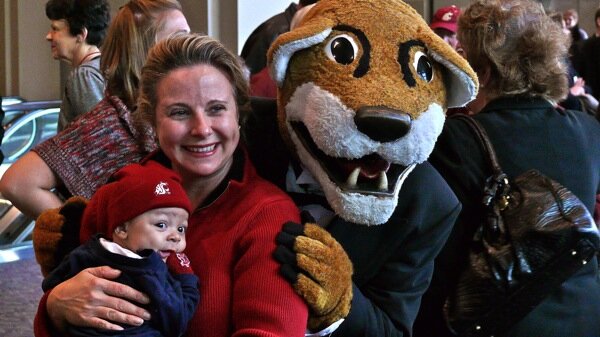Michael van Baker
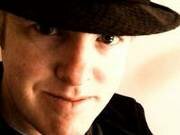
About Michael van Baker:
Neighborhood: |
Capitol Hill |
Last Login: |
2 hours ago |
Joined: |
September 01, 2009 |
Profile viewed: |
2687 times |
Total Audience: |
361672 views |
| Editor & Publisher of The SunBreak | |
Storiesby Michael van Baker |
View by List | Grid |
"Talking about rain... a LOT is coming starting Sunday, with the establishment of a significant pineapple express event," says UW meteorologist Cliff Mass. "And a super warm front." [UPDATE: "Atmospheric River."] His post is mainly about the squall line that blew through Wednesday morning, drenching the city, but the National Weather Service goes into a bit more detail.
From Saturday night through Monday, we should be experiencing a pineapple express weather system, which besides dumping a lot of rain on us, will raise the snow level to 7,000 feet--adding some snow melt to the rain-swollen rivers in the area. It's not clear yet from the models where the intensity of the rains will be strongest, so stay tuned.
KOMO's Paul Deanno says it could be the wettest storm in two years, adding that "if the rain goes for 24 hours or longer, we'll probably be dealing with flooding on the Nooksack, Skagit, Stillaguamish, Snoqualmie, Satsop and Bogachiel Rivers. If the rain keeps going, even the more stubborn-to-flood rivers like the Chehalis and Cowlitz could go over their banks." On the bright side, the NWS advises that the flood risk for the Green River is minimal.
The Tunnel + [Unfunded] Transit people have sent out an email denouncing both SCAT's stop-the-tunnel initiative and the more recent Move Seattle Smarter initiative that seeks to protect Seattle taxpayers from deep-bore tunnel cost overruns.
"The bored tunnel option is the only alternative that keeps the viaduct open during construction, linking neighborhoods and assuring that freight can move through and around this City. The opponents’ plan would put 110,000 vehicles a day on surface streets and I-5 killing business and jobs," says Dave Gering, of the Manufacturing Industrial Council of Seattle, in the release.
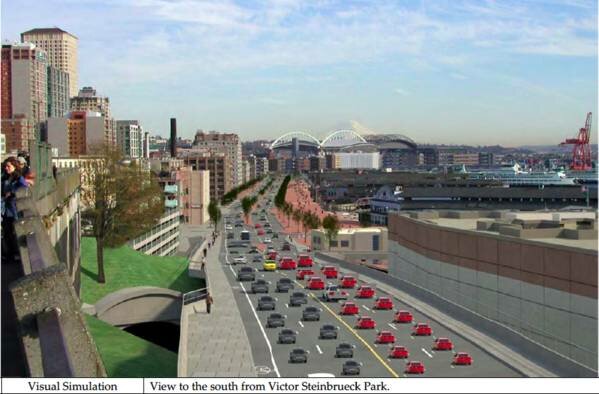 WDOT created a visualization of the waterfront boulevard that comes with the tunnel.
WDOT created a visualization of the waterfront boulevard that comes with the tunnel.
I've tried to help it reflect actual traffic.
Gering is quoting the high estimate for daily traffic on the Alaskan Way Viaduct currently, but he fails to mention that the tolled deep-bore tunnel is expected to handle only 47,000 daily vehicles. Some 35,000 cars are anticipated to take--that's right--city streets and I-5.
The difference between the Surface/Transit/I-5 alternative and the deep-bore tunnel is that dealing with surface street traffic is the primary goal of the former, while the tunnel plan does little to mitigate the traffic it sends to I-5 or city streets. There is $190 million recommended for transit as part of the tunnel plan, but it is unallocated, which is another way of saying that the tunnel plan contains 190 million wishes.
WDOT's SDEIS notes that of all the options the Surface/Transit/I-5 alternative is the only one that actually would help the state to reach its stated goal of reducing traffic-related greenhouse gas emissions; the tunnel would lead to increased emissions by 2030. The SDEIS also notes that by 2030, congestion from traffic using the tunnel is expected to be slightly worse than that from traffic using the Viaduct in 2015.
A view of San Francisco's Embarcadero Boulevard as seen on Google Maps
As you review WSDOT's visualizations (Appendix E) of what the tunnel and waterfront would look like, keep in mind this actual image from San Francisco's Embarcadero Boulevard. The median is fairly broad because streetcars run up and down it. People have, in all seriousness, told me that we can't afford to have something like this on our waterfront, as pedestrians would refuse to walk across such a wide expanse. With the tunnel option, a future streetcar might run along First Avenue, rather than the waterfront.
Comments on the SDEIS are due December 13, 2010. Comments can be e-mailed to awv2010SDEIScomments@wsdot.wa.gov or mailed to Angela Freudenstein, Alaskan Way Viaduct Replacement Project, 999 Third Ave., Suite 2424, Seattle, WA 98104-4019. In other tunnel news, tomorrow the state is expected to unveil the actual dollar bids from the two construction teams who have not dropped out yet.
Seattle is becoming flash mob town USA. This past Saturday, December 4, local choreographers Bobby Bonsey and Beth Meberg, along with 50 or so other Seattleites, entertained holiday shoppers in Occidental Park and Westlake Center by dancing to an "Umbrella/Singin' in the Rain" mashup inspired by a recent episode of Glee.
You wouldn't think there was anything there to get cranky about, but you underestimate Seattle curmudgeonry. All the umbrella-waving was the showy part of SDOT's new $50,000 pedestrian-awareness campaign, designed to make drivers remember that colliding with people in crosswalks is rude. As KING 5 told it, via an interview with a disgruntled business owner who was upset that ice makes steep hills difficult to drive on with winter:
"You could hear as a truck or a car lose traction on that hill and start to go sideways," said Bevis. He says the slippery slope cost him three days of business. Now, he complains SDOT is spending $47,000 on the umbrella campaign, which is funded by the "Bridging the Gap" levy passed by voters four years ago.
That makes it sound like the city is spending $47,000 on umbrellas, which is far from the truth. Most of the money is going for "Metro bus ads, posters, stickers on pay stations, window displays, and publicity events"--just $5,000 went for the brightly covered umbrellas, which are meant for downtown shoppers to use and then leave for the next person. (If you see someone wandering around outside of downtown with an umbrella that says SDOT on it, you'll know they're a thief.)
Metro bus advertising, besides reaching exactly the people who need to be reminded to look for pedestrians, supports transit service, so the money actually ends up working pretty hard for the public.
That's not good enough for Crosscut, who label the initiative a boondoggle. "Wouldn't that $50,000 save more lives if applied to law enforcement or the social safety net, if it prevented one more murder by a mentally ill person not getting the right help?" asked Knute Berger. Save one life?
It took Publicola's Erica Barnett to dig up real numbers on pedestrian safety, noting that in winter car v. pedestrian collisions double from summer; they reached a "high of 194 in November (and 184 in January)" from 2006 to '08. That's over two people struck by a car per day in November and in January.
As Seattle Transit Blog notes, the negative media stories never manage to include the part about people getting run over in crosswalks--they avoided it entirely. Someone ought to develop an awareness campaign about that.
A few years ago, Curitiba mayor Jaime Lerner was in town, and I will always remember the look he had on his face, as he remembered learning that we had built one huge stadium for baseball and another huge stadium for football right next door. Along with the awe at the amount of money Seattle had to throw around*, there was clearly pity for our great stupidity and selfishness.
On Lerner's list of five things for a sustainable city, number five is "make facilities multiple-use." Partly because it's the least you can do if you're using public funds, but also because their presence is a gift from the community. They take up public space, make demands on public infrastructure, so it's part of the deal that they get used as widely and often as possible.
You can argue over the folly of having the two stadiums--please, have at it--but there they are. Since we do have our two mega-stadiums, it beggars belief that at this particular time in economic history, the University of Washington would decide to raise $250 million for a new Husky Stadium, rather than simply put one of them to better use.
There's a Danny Westneat interview with Mick McHugh that spells out the obvious alternative: Just play at Qwest Field. The logic is unassailable since, no matter what, the Huskies will play at Qwest Field--that's where they'll be meantime if the new stadium is constructed. Seth has argued that tradition is at stake--an intangible good, how do you put a price on that?--and there's no question that it is. Just listen to the UW Board of Regents describe the project:
Plans include the complete demolition and reconstruction of the lower bowl and southside upper stands. [...] Premium seating opportunities, including 25 suites, 25 loge boxes, and over 2,500 club seats, will be built into the facility.
That is, what's being destroyed is the original stadium, built in 1920. It's being replaced by very expensive seating.
I appreciate the fact that the UW department of Intercollegiate Athletics is responsible for the funding, and that they'll do this by issuing 30-year bonds backed by revenues from donations ($50 million) and increased income (naming rights, premium seating, soaking the Tyee Club). But whether you think that UW football fans will give more willingly to the UW if they have a brand-new stadium to cement their commitment or not, you have to realize that they are not an inexhaustible source of income, and this stadium is being built to extract as much of that as possible.
I'd be more sympathetic to the university's claims that it is worried about student attendance at Qwest (despite new light rail that will take students directly there), if their plans didn't call for booting students out of their existing prime location to the west end zone. And that's not even getting into the impact of 70,000 people streaming into the Montlake neighborhood on weekends, which traffic Qwest is far better able to accommodate.
Let me phrase this as a sports question--does the UW have their eye on the university's economic ball? Ironically, Scott Woodward, the UW's athletic director was just called on the carpet for suggesting that an over-emphasis on sports can be bad for a university: "In my mind, it's a wonderful athletic facility," Westneat quotes Woodward saying of Oregon's remodeled sports complex. "But they've watched it at the expense of the university go really down."
The Regents haven't given us a comparison, side-by-side, of leasing Qwest for 30 years versus building a new stadium. But they have already raised tuition for those 700-student biology classes, and now the legislature is preparing for a special session to deal with a chronically increasing deficit. ("Gregoire has already put forth some budget-balancing options, including elimination of the Basic Health Plan and raiding federal education dollars.")
How will the Regents address further cuts to state funding, given that the cost of attending the UW has already tripled in the last 20 years? What is their plan if and when stadium revenues fail to meet projections because our challenging economic climate continues?
This is not a question of misplaced priorities, but of simple common sense.
*Actually, debt. In 2015, Seattle will finish paying off what it owes on the Kingdome, the multi-purpose stadium demolished in 2000.
Veteran muckraker Rick Anderson has long been one of the pleasures of occasional thumbings through the Seattle Weekly. He's institutional memory in a town that likes to forget the unpleasantness of its rowdier days. Writes Anderson:
Civic scandals used to mean something in Seattle. Gunslinger Wyatt Earp paid off City Hall to operate his 1890s gambling joint here. In the 1950s, bar owners were leaving lunch bags of money on their counters for beat cops who threatened to shut them down if they didn't. A half-century later, aging mobster Frank Colacurcio did what he could to keep corruption alive with a political payoff scandal known as Strippergate.
His true-crime expedition Seattle Vice, from local publishers Sasquatch Books, uses the life of stripper magnate Frank Colacurcio to tie together Seattle's frontier years with its internet-age reinvention. The long-lived Colacurcio died at 93, and was a crime figure with connections for about three-quarters of a century, beginning with a morals charge for having sex with a 16-year-old girl when he was 25. He was defended by pre-Governor A. D. Rosellini, but was convicted.
Sixty years later, Rosellini would prove to be "part of the effort led by Frankie to provide cash to family and friends that would be forwarded as individual donations to the three Council members, Nicastro, Wills, and Compton." It was quickly dubbed Strippergate, and Colacurcio's attempt to negotiate favorable rezoning of a strip club's parking lot blew up into something far bigger, ending the Council careers of the three mentioned. Rosellini, it appears, was guilty only of poor judgment.
As Anderson tells it, this kind of canoodling is purely traditional, stemming from the Seattle "Nice" that visitors hear so much about. Whether it's true tolerance or just an unwillingness to be bothered, as late as the mid-'50s madam Nellie Curtis was running a string of brothels in Aberdeen; she'd moved out there after paying off Seattle's police cut into her profit margins too substantially. (Payoffs to the SPD continued through the 1970s, when gay bars found that money could keep busts away.)
Besides charting Colacurcio's rise, Anderson takes time out for Bobby Kennedy's investigation of the Teamsters, Tacoma's "Carboneheads," Chinatown's Wah Mee shooting spree, downtown's hapless "Smooth," and Seth Warshavsky's short-but-happy internet porn empire, while exploring why the Northwest is no country for young mobsters, just older burn-outs in Witness Protection.
It's all recounted in hardboiled journalist deadpan; some of the most interesting moments come when you suspect the unnamed reporter getting the quote from Colacurcio, working behind the bar at the Firelite Room (now the Nitelite), could have been Anderson himself. You'll probably want to take a shower (or two) after reading, but when it comes to understanding polite Seattle's blindness to a criminal status quo, Seattle Vice shows you that there's usually money being made.
 After a brief hearing in late November, Amanda Knox's appeal process is set to begin again in Perugia on December 11. The Seattlepi.com's Andrea Vogt says the appeal makes its case along two fronts: offering alternative suspects for the murder of Meredith Kercher, nominated by prison inmates, and continuing to critique the DNA evidence.
After a brief hearing in late November, Amanda Knox's appeal process is set to begin again in Perugia on December 11. The Seattlepi.com's Andrea Vogt says the appeal makes its case along two fronts: offering alternative suspects for the murder of Meredith Kercher, nominated by prison inmates, and continuing to critique the DNA evidence.
Convicted child killer Mario Alessi has three other inmates who back up his claims that Rudy Guede told him Sollecito and Knox had nothing to do with the murder, while Mafia snitch Luciano Aviello says his brother did it. The DNA challenge is perhaps trickier because, in essence, Knox's defense has to argue that "everyone else" has higher forensic standards than Italy:
The amount of Kercher's DNA found on the blade was such a trace amount it registered with a "too low" reading when analyzed.
A top geneticist at one of Europe's top forensic labs at the University of Salzburg confirmed in an interview with seattlepi.com that it is possible to amplify such a small amount of DNA, as Stefanoni did, until DNA can be identified.
But the expert added that it would not be allowable unless the result could be reproduced, something police biologist Stefanoni said under cross-examination could not be done.
Meanwhile, the race is on for the Lifetime movie about murder of Meredith Kercher to come out--in March--before Amanda Knox's appeal might free her (the Seattlepi.com's source says that a reduction in sentence, if anything, is more likely). A Cambridge grad student with a remarkable likeness to Kercher has been cast opposite Hayden Panettiere's Amanda Knox. Director Robert Dornheim professes not to care that much about the legal wrangling: "What interests me more is the psychology and personality of the protagonists rather than the blood of the crime and the search for those responsible."
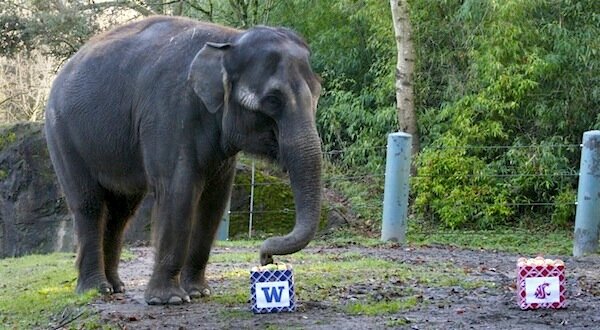 Woodland Park Zoo sports enthusiast Chai ponders who will win the Apple Cup.
Woodland Park Zoo sports enthusiast Chai ponders who will win the Apple Cup.
(Photo: Dennis Dow/Woodland Park Zoo)
- Metro raising bus fare in January (My Ballard)
- Local holiday shopping by bicycle (Beacon Hill Blog)
- The Key Ring Kid busted but 'master key' burglaries continue (Capitol Hill Seattle)
- A grand opening at 23rd and Union: Louisiana Grill celebrates with freebies (Central District News)
- Seattle Times: Film that was partly shot at Eastlake Zoo will screen at Sundance (Eastlake Ave)
- Lenin Lighting 2010: Videos & Photos (Fremont Universe)
- New Brewery in Georgetown??? (Blogging Georgetown)
- Green Lake’s Streetwise Gardener: Dare to Be Dull (My Green Lake)
- School district announces snow make up plan (Magnolia Voice)
- Hiding in Maple Leaf, a holiday hot shop (Maple Leaf Life)
- Local students’ questions, advice featured in national book to Michelle Obama (PhinneyWood)
- Man found dead in Queen Anne alleyway (Queen Anne View)
- Only 10% of Seattle’s Black Students Attend High-Performing Elementary Schools (Rainier Valley Post)
- Ravenna Blog joins the Seattle Times Local News Partnership (Ravenna Blog)
- Parka Party 2010 brings $5,000 in donations to local non-profits (Roosiehood)
- St Dames Celebrates SE Community with Grand Opening & Recipe (Southend Seattle)
- Light rail's mixed blessing (South Seattle Beacon)
- Winter Indoor Floating Market Aboard the Virginia V (The Southlake)
- $57,000 bells for sale at the UW (U District Daily)
- Pedestrian safety a big concern at this time of year (My Wallingford)
- Low-key town-hall meeting for Mayor McGinn in West Seattle (West Seattle Blog)
- Elephant predicts Apple Cup 2010 Winner (Woodland Park Zoo Blog)
-
Thank god for Wade Madsen. I could watch that guy do anything. Eat dessert, for instance. Last night, I went to see Dayna Hanson's "Gloria's Cause" at On the Boards (through Dec. 5) and there he was, eating cherry pie. Big as life!
He was concerned, as I overheard from a conversation with dancer Jessie Smith, that if he, Wade, read a letter for her, we, the audience, might become confused that he was the letter's author--Paul Revere--rather than George Washington, which is the plum role he was really looking forward to playing. (Thus, I'm assuming, the cherry pie association, rather than the more immediate Warrant reference.)
That is another reason to be thankful, because honestly it is not very easy to track what's going on onstage, which ranges from reenactments of the Albany Congress in 1754 to the writing of the Declaration of Independence and the Revolutionary War, while Jessie Smith and Jim Kent dance, the band Today! plays songs, and Madsen, Pol Rosenthal, Peggy Piacenza, and Hanson herself act out informal "real world" vignettes. Oh, and of course, there's the meta-commentary of the overheard moments as I described above.
I find myself grudgingly respectful of this palimpsest formalism; at times, "Gloria's Cause" plays like a Schoolhouse Rock for a new generation--you might be baffled at how anyone might learn something from it, but it's agreeable and it has a fun beat. On the didactic side, you learn about Deborah Sampson (danced by Jessie Smith), the woman who dressed as a man so she could enlist in the Continental Army.
There's also a scene where Rosenthal, Dave Proscia, and Madsen are quibbling over who's going to get started writing the Declaration--their fearful knees shake so much their pants fall down, and the performers admit to a failure when it comes to really connecting with the wording of the hallowed document. Later, Madsen has a very fine moment as a drunken, defensive George Washington appearing on a trashy ambush talk show to berate a soldier who called him "wishy-washy." (True story, at least about the doubts in his command.)
It's Piacenza, in red bra and panties beneath an Army trenchcoat, and wearing a eagle's head, who finally locates the rage and frustration that rises from the gap between our country's founding rhetoric and consistent inability to quite measure up. Her call-for-empathy polemic spirals out of control, out of language, and into a wounded-bird flopping around the stage. It was a little too fierce for some, who tittered. But I would have liked to have seen more of that passion. As I say, I can respect the discontinuities, the "blurring of the edges" to allow for a little less iconography and a little more relatability, but I felt more entertained and less moved or provoked than I'd hoped. (I don't really love slideshows in live theatre, but the music--Today! ladies and gentlemen--was good.)
This feels a little ungracious, because the evening is filled, from start to finish, with strong performances, from Pol Rosenthal's opening monologue and Peggy Piacenza's outburst, to the seemingly ceaseless pas de deux of Jim Kent and Jessie Smith, and ensemble unisons that kept the individuality of the dancers, from Madsen's storky elegance and Smith's serene glee, to Hanson's spare watchfulness. If the ideas here never fully coalesce, neither has our goddamn nation.
WikiLeaks' Twitter stream
Already someone with a lively sense of irony has visited Amazon's listing for the book The Pentagon Papers, writing:
Amazon pulled Wikileaks from their site because it represented classified government documents. So what is the Pentagon Papers still doing on this site? Oh right, Amazon wasn't around in 1971 to cave in to pressure from right wing politicians to betray the First Amendment right to publish classified materials that have been leaked by others.
TechFlash reports that Pentagon Papers-leaker Daniel Ellsberg himself is calling upon Amazonians to get into the transparency habit:
This would be a good time for Amazon insiders who know and perhaps can document the political pressures that were brought to bear—and the details of the hasty kowtowing by their bosses—to leak that information.
At issue is Amazon's claim that because WikiLeaks violated their terms of service hosting agreement by posting material they didn't own, Amazon was forced to terminate their hosting services--that is, it wasn't in response to governmental suasion. The Stranger's Paul Constant isn't buying it: "They need to issue a brief, clear statement on their information policies so consumers know where they stand with Amazon. If they're not going to fight for their customers' rights, their customers need to know that."
Amazon's hosting of the material aside, Salon's Glenn Greenwald can't understand why Tableau, a Seattle interactive graphics software company, also agreed to pull WikiLeaks charts in response to a request by Senator Joe Lieberman, chair of the Senate Homeland Security Committee. "These charts contained no classified information whatsoever, and disclosed nothing about the content of the cables," writes Greenwald. (See an example here.)
Washington State University announced today that billionaire Paul Allen is making a gift of $26 million to WSU's School for Global Animal Health. It's the largest single charitable contribution he's made, said Allen, WSU's most illustrious dropout, at an event at Seattle's Convention Center.
"Washington State University has been important to me since I was a student there in the 1970s. Our family foundation, under the leadership of my sister Jody, has supported a number of programs at WSU. And today, I am happy to be able to make a significant personal gift to help WSU broaden its reach and touch many more lives," said Allen in a prepared statement.
The gift makes it the School for Global Animal Health that Microsoft built. The Gates Foundation provided $25 million for the school's construction in 2008. Besides the obvious implications for livestock health, the school will also focus on animal-to-human disease transmission: "Zoonotic diseases--infections transmitted from animals to humans--account for more than 70 percent of human infectious diseases," notes WSU. Construction is expected to finish in 2012, and the new building will be named the Paul G. Allen Center for Global Animal Health.
Allen's gift was tied to WSU's announcement that its $1-billion capital campaign--in a quiet phase since 2006--had raised over $500 million. With Allen's gift, donors have pledged $532.2 million. Now the university will be going public with its fundraising, as it tries to collect the rest by 2015.
WSU President Elson Floyd and campaign chair Scott Carson emphasized that the campaign was aimed at development of the land-grant university, its infrastructure and resources, and was not a response to declining education funding from the state. (Carson in particular underlined the fact that funding education is the state's primary duty.) That being said, close to $200 million of the campaign is dedicated to scholarships and fellowships for students. $250 million is earmarked for attracting and retaining high-powered faculty.
In something of a statement, the reception at Seattle's Washington State Convention Center was linked electronically with WSU campuses in Pullman, Spokane, Tri-Cities, and Vancouver, as well as the research and extension centers in Prosser, Mount Vernon, Puyallup, and the tree fruit research and extension center in Wenatchee--in addition to international WSU research locations.
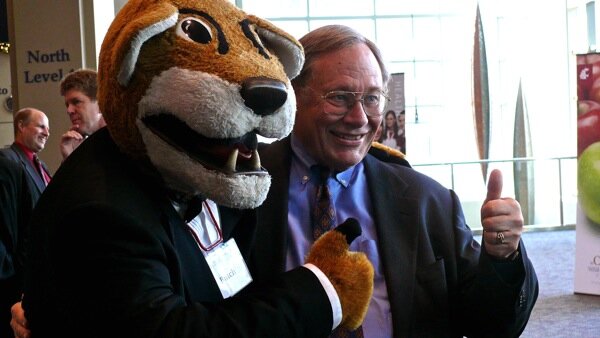 WSU's mascot Butch poses with the Trade Development Alliance of Greater Seattle's Bill Stafford
WSU's mascot Butch poses with the Trade Development Alliance of Greater Seattle's Bill Stafford

